 W
WThe Aeronautical Medal is a state decoration of France established by the decree of February 14, 1945. It is awarded to both military personnel and civilians for outstanding accomplishments related to the field of aeronautics. Originally envisioned before the Second World War, it was intended as an equal to the Order of Maritime Merit. The intent was to create an aerial order of merit intended for civilian and military personnel working in aeronautics. The war temporarily put an end to the project until February 1945.
 W
WThe Ordre du Mérite civil of France was created on 14 October 1957 to reward individuals who have rendered services reported to the state as part of the Ministry of Interior, or to departments, municipalities and public institutions. The order is managed by the Interior minister, assisted by a Council of the Order.
 W
WThe Combatant's Cross is a French decoration that recognizes, as its name implies, those who fought in combat for France. The Poilus of World War I worked toward recognition by the government, of a special status to those who had participated in the bitter fighting of 1914-1918. The law of 19 December 1926 created la "carte du combatant", or combatant's card, for veterans of 1914-1918, as well as for the veterans of 1870-1871 and colonial wars before the First World War. The decoration was created only three years later by the law of 28 June 1930.
 W
WThe Commemorative medal for voluntary service in Free France was a French commemorative war medal established by decree on 4 April 1946 on the 1945 proposition of general Edgard de Larminat to the Minister to the armies.
 W
WThe Volunteer combatant's cross 1914–1918 is a French decoration that recognizes those who volunteered to serve on the front in a combat unit during World War I. When the 1914–1918 Commemorative war medal (France) was established, it was anticipated that a clasp bearing the words, "ENGAGÉ VOLONTAIRE", would be worn on its ribbon for those who had freely and voluntarily enlisted in the French Armed Forces for combat service. While the clasp was produced, it was short lived due to parliament demanding the establishment of a special insignia to distinguish the special merit of the voluntary combatant.
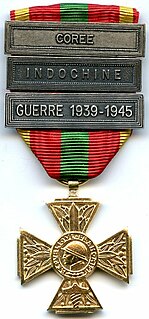 W
WThe Volunteer combatant's cross was a French decoration that originally recognized those who volunteered to serve in a combat unit during World War II. It is the equivalent of the "1914–1918 Volunteer combatant's cross".
 W
WThe Cross of the Resistance Volunteer Combatant is a French decoration that recognizes, as its name implies, those who fought in one of the resistance groups, or who were deported or interned for acts of resistance, or who were killed or injured while taking parts in acts of resistance against the German occupation forces during World War II. This award was created by a special law in 1954 and awarded to those who had been designated and issued cards certifying them as voluntary resistance fighters.
 W
WThe Dardanelles campaign medal was a French military medal bestowed for participation in the Battle of the Dardanelles, also known as the Gallipoli campaign against the Central Powers by the Corps expéditionnaire d'Orient supported by the Royal Navy and French Navy between 25 April 1915 and 9 January 1916.
 W
WThe National Defence Medal is a French military decoration. It was created by Charles Hernu, Minister of Defence and established by decree on 21 April 1982. It rewards particularly honourable service rendered by military personnel for their participation in operational activities. The medal has three levels: Gold, Silver and Bronze.
 W
WThe Dunkirk Medal is an unofficial commemorative medal created by the town of Dunkirk to commemorate the defence of the town and surrounding area during May and June 1940. The allocation of the award was managed by nationale des anciens combattants de Flandres-Dunkerque 1940, the French National Association of Veterans of the Fortified Sector of Flanders and Dunkirk.
 W
WThe Étoile Civique was created by the Académie française in order to reward dedication to people and honor behavior and actions which attest this.
 W
WThe French commemorative medal is a French decoration intended to recognize civilians and soldiers who took part in specific missions ordered by the French government carried out outside of French national territory after March 1, 1991. It was established by decree 95-1098 on 9 October 1995 on the initiative of the then Defence Minister, François Léotard.
 W
WThe Honour medal for courage and devotion is a French decoration than can be bestowed to individuals and whole units. It is awarded for acts of courage during a rescue. The Honour medal for courage and devotion was created on 2 March 1820 by King Louis XVIII. It has gone through several designs during its long history. The award was given its present name by a decree of 16 November 1901.
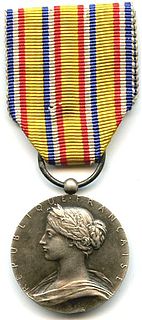 W
WThe Honour medal for firefighters is a state decoration of France bestowed by the Ministry of the Interior to members of the French Fire Service.
 W
WKnown for a long time as the President’s medal, the Honour medal of Foreign Affairs is a state decoration bestowed by the French Republic in the form of an honour medal for work. It was originally created by a Royal decree of 28 July 1816 as a single grade medal to reward acts of courage displayed by French nationals on foreign soil. An 1861 Imperial decree saw it be split into the silver and gold grades. The year 1887 saw the addition of swords to the medal for award to both French or allied military personnel for acts of courage in favour of the French in time of war. Although still bestowed in wartime for courage, the modern award is now aimed at rewarding civil servants of the ministry for Foreign Affairs.
 W
WThe Honour medal of railroads is a state decoration bestowed by the French Republic in the form of an honour medal for work. It was originally meant to reward, depending on the quality and length of time calculated in calendar years, the services rendered by French agents and labourers and to nationals of the French Union or protectorates, in service with the railroads. The Honour medal of railroads was created by decree on 19 August 1913 as a reward for thirty years of service. Since then, many modifications were instituted by consecutive decrees amending the original text.
 W
WThe Insigne des blessés civils is a French distinction for civilians, irrespective of age or sex, who have been injured or maimed as a result of war.
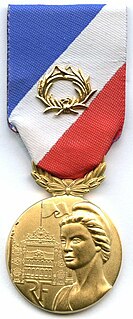 W
WThe Medal for internal security is a French civil and military medal established by Decree No. 2012-424 of 28 March 2012.
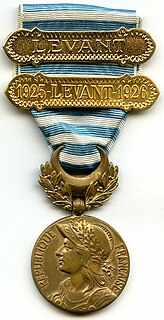 W
WThe Syria-Cilicia Medal was a French decoration awarded to military personnel engaged in the hostilities that erupted in the Middle East in the immediate aftermath of World War I.
 W
WThe Military Health Service honour medal is a French decoration created 30 August 1962. The medal recognizes individuals who have contributed or lent their support to the French Defence Health service and were particularly marked by their services or their dedication. It is presented in four different levels: gold, vermeil, silver, and bronze. It may be awarded to members of the military as well as civilians.
 W
WThe Médaille de la Famille française is a decoration awarded by the government of France to honour those who have successfully raised several children with dignity. The decoration was created by a decree of May 26, 1920, under the name Médaille d'honneur de la famille française, with the aim of honouring mothers of large families. Although the medal rewards those with large families, the children must be "raised well" and the eldest be at least 16 years old.
 W
WThe Médaille de la Gendarmerie nationale is a French military decoration created on 5 September 1949 on proposition of the then Minister of Defence, mister Paul Ramadier. It was originally created in a single grade for award to officiers and NCOs of the Gendarmerie nationale who were cited in the orders of the entire service. Such a citation in the orders of the entire service, and all potential subsequent ones would be denoted by a grenade device on the ribbon as the medal could, and can still only be awarded once to any potential recipient. The medal could also be exceptionally awarded to persons not members of the service for important services rendered to the gendarmerie or for help during special missions. These presentations were made without a citation and thus without any ribbon device.
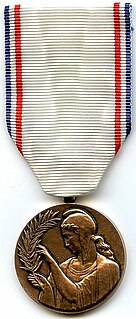 W
WThe Medal of French Gratitude was a French honour medal created on 13 July 1917 and solely awarded to civilians. The medal was created to express gratitude by the French government to all those who, without legal or military obligation, had come to the aid of the injured, disabled, refugees, or who had performed an act of exceptional dedication in the presence of the enemy during the First World War. The creation of this distinction was mainly the result of unsuccessful offensives of General Nivelle in 1917 and the serious crisis of confidence in France. The French government thus wanted to thank those who, despite the crisis, were always volunteering. It has three classes: bronze, silver, and gold. Nearly 15,000 people and communities were recipients of this award. The medal is no longer awarded, the last award was on 14 February 1959.
 W
WThe Medal for civilian prisoners, deportees and hostages of the 1914-1918 Great War was a commemorative medal awarded to French civilians who were deported from the German occupied French territories and interned in camps during World War I. A law of 14 March 1936 announced the government's intention to officially recognize the sacrifices and patriotism of the French civilians that were forced from their homes and into prison camps to serve as hostages or to be detained with a new medal. The law of 25 August 1936 officially established the award.
 W
WDuring the war of 1914-1918, the populations of the invaded and occupied regions of France were put under severe strain. Thus, at the end of hostilities, it seemed necessary to pay tribute to the courage of these people by rewarding them with several medals such as the Medal for victims of the invasion, the Medal of French Fidelity and the Medal for civilian prisoners, deportees and hostages of the 1914-1918 Great War. It was on the proposal of the Minister for the Liberated Regions that the Medal for victims of the invasion was created on 30 June 1921 in three classes.
 W
WThe Medal of a liberated France was a decoration of the French Republic created by decree on 12 September 1947 and originally named the "Medal of Gratitude of a Liberated France". It was intended as a reward for French and foreign nationals that had made a notable contribution to the liberation of France from the German occupation.
 W
WThe Medal of the Nation's Gratitude is a French state decoration established on 12 April 2002 by decree 2002-511 and awarded to civilians, veterans of civil or military service, and to members of the French armed forces previously awarded the "Title of the Nation's Gratitude", a governmental scroll certifying to honorable service abroad.
 W
WThe Ordre du Mérite combattant was a ministerial order of merit of France created on 14 September 1953 to reward individuals who distinguished themselves by their service and dedication in the management of the moral and material interests of veterans and war victims. These individuals' applicable service could be working in the Ministry of Veterans and War Victims or for organizations and associations who work for veterans. The order was administered and awarded the Ministry of Veterans and War Victims.
 W
WThe Ordre du Mérite militaire was a ministerial order of merit of France created on 22 March 1957 to recognize the contributions of active members of the military reserves during times of peace. The order was administered and awarded the Ministry of Defence. The order was created to replace the Croix des services militaires volontaires established in 1934. Holders of the Cross were made members of the Ordre du Mérite militaire, bronze holders as knights, silver holders as officers, and gold holders as commanders.
 W
WThe National Recognition Medal for Victims of Terrorism is a national medal of France awarded to French victims of terrorism. Established by presidential decree on July 12, 2016, it may be awarded to French or foreign nationals who are victims of terrorism in France or abroad. The medal may be awarded to a retroactive date of January 1, 2006. The medal was created to give a proper recognition to the sacrifice of terrorism victims while still maintaining the award criterion of existing national honours such as the Legion of Honor. In Spain there is a similar honour known as the Royal Order of Civil Recognition for Victims of Terrorism.
 W
WThe North Africa medal was a French commemorative medal established on 29 April 1997 by French President Jacques Chirac via decree 97-424, following an initiative of Pierre Pasquini, Minister for veterans' affairs and victims of war who expressed "the importance that an exceptional decoration be established for those who had fought in North Africa". Already in 1996, Minister Pasquini, President Chirac and Prime Minister Alain Juppé had requested that the existing "Title of the Nation's Gratitude" in the form of an official scroll already awarded to soldiers and civilians having served in North Africa between 1952 and 1962, finally be linked to the award of a specific medal.
 W
WThe Commemorative Medal for Security Operations and the Maintenance of Order is a French commemorative medal established in the late 1950s for award to members of the French armed forces and French civil servants under military authority for service in French North Africa during the hectic years that would become the end of French colonialism in the region.
 W
WThe Order of Tahiti Nui was established on 5 June 1996 by the Assembly of French Polynesia to reward distinguished merit and achievements in the service to French Polynesia.
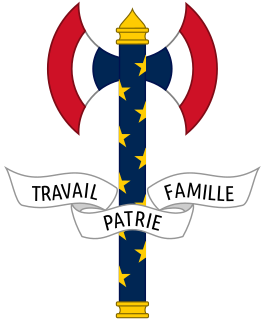 W
WThe Order of the Gallic Francisque is an order and medal which was awarded by the Vichy Regime, the Nazi-aligned government of France during World War II.
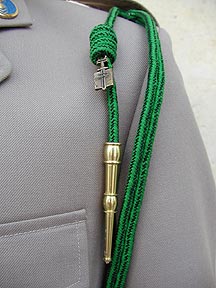 W
WThe Order of Liberation is a French Order which was awarded to heroes of the Liberation of France during World War II. It is a very high honour, second only after the Légion d’Honneur. Very few people, military units and communes were ever awarded it; and only for their deeds during World War II. A different order, the Médaille de la Résistance, was created and awarded for lesser but still distinguished deeds by members of the Resistance.
 W
WThe Ordre des Palmes académiques is a national order bestowed by the French Republic on distinguished academics and teachers and for valuable service to universities, education and science. Originally established in 1808 by Emperor Napoleon as a decoration to honour eminent members of the University of Paris, it was changed into its current form as an order of merit on 4 October 1955 by President René Coty, making it one of the oldest civil honours bestowed by the French Republic.
 W
WThe Ordre du Mérite Maritime is a French order established on 9 February 1930 for services rendered by seafarers to recognise the risks involved and the services rendered by seamen, and reflect the important economic role of the Merchant Navy to the country. The order was reorganized in 1948, and again by decree on 17 January 2002.
 W
WThe Honour medal of the National Police is the highest award of the French National Police, which falls under the jurisdiction of the Ministry of the Interior.
 W
WThe Political deportation and internment medal is a commemorative medal awarded by the Ministry for veterans and war victims of the French Republic to its citizens who were deported or interned by the German occupation forces during World War II.
 W
WThe law of August 22, 1950, establishing the status of “recusant”, stated in its first article: "The Republic, grateful to those who accepted all the risks in their fight against the enemy's war potential, considering the suffering and the prejudice that this courageous and patriotic attitude caused them, proclaimed and determined the right to reparation for recusants and their successors.
 W
WThe Resistance medal was a decoration bestowed by the French Committee of National Liberation, based in the United Kingdom, during World War II. It was established by a decree of General Charles de Gaulle on 9 February 1943 "to recognize the remarkable acts of faith and of courage that, in France, in the empire and abroad, have contributed to the resistance of the French people against the enemy and against its accomplices since 18 June 1940".